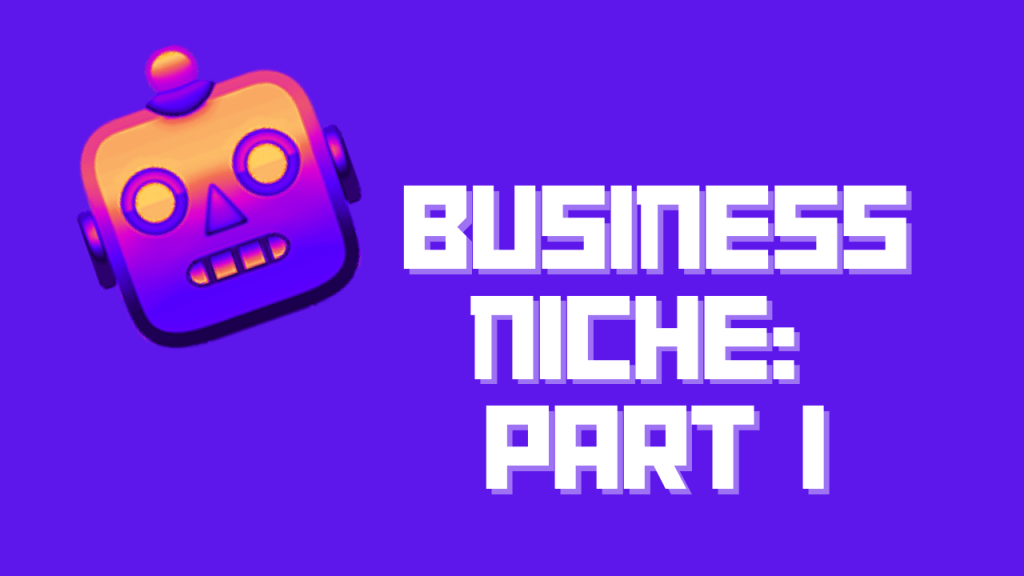Hey Prompt Entrepreneur,
Thank you as always for voting! It really helps guide my writing so that it’s valuable for you, which is all that matters.
Otherwise I’d get super distracted and go deep on something that is only interesting to me and, maybe, 3 other people.
The vote this week was between working on the entrepreneurial mindset or honing in on our business niche.
Business niche beat mindset to the post 60% to 40%. Pretty close!
This week therefore we’ll be covering the following topics:
Part 1: Exploring Your Interests and Skills
Part 2: Getting Clear on Your Motivations
Part 3: Finding Your Niche
Part 4: Validating and Refining Your Idea
Part 5: Planning Next Steps
Let’s get started:
1. Uncovering our skills
First up we’re going to work to uncover your skills.
For some people this is easy. You know what you’re good at!
For others it’s an excruciating process.
If you lack self-confidence, or are just super modest, you might think you aren’t really very good at anything.
Generally this isn’t true. You will have skills but not the confidence to declare them.
Alternatively you might be so good at some things that you no longer think of yourself as good at that thing.
For example just yesterday I fixed my mum’s printer. I don’t consider myself “good at” printers and certainly wouldn’t list it as a skill but I got the issue solved in a few minutes.
Objectively it is a skill that I have, even if not explicitly recognised as such. You’ll have lots of similarly unrecognised skills.
We’re going to use a coaching prompt to elicit our skills from us. Here’s the prompt:
Act as a coach
I often find it hard to know what I'm good at - please coach me to help me curate a list of my skills.
Ask me questions about life, work and my hobbies until you have extracted my skills.Use this in a new chat and ChatGPT will begin a coaching process, much as if you were sitting with a human coach.
💬 Prompt Output:
ChatGPT will first ask a broad set of questions:
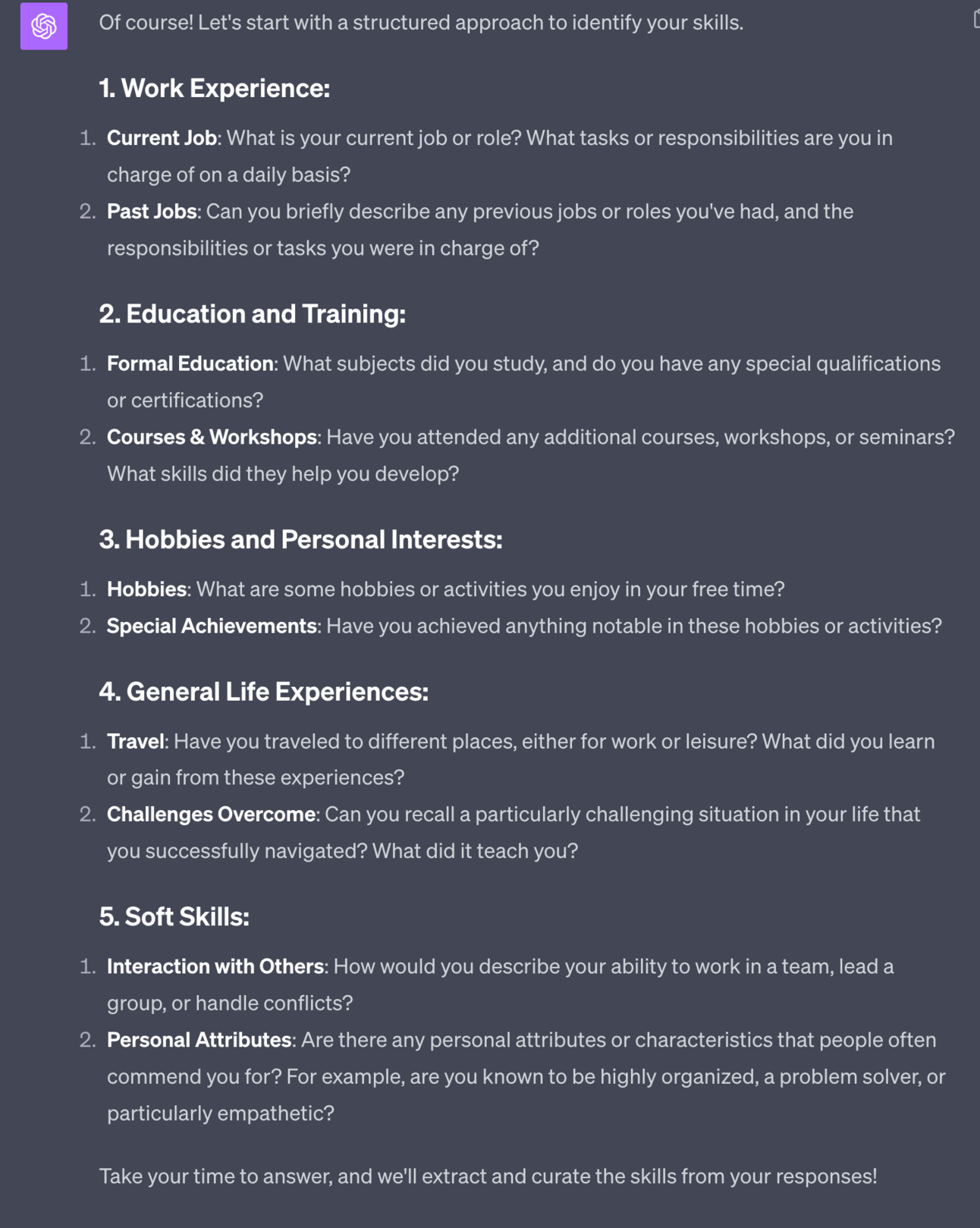
Choose an area to explore. Don’t worry about doing them all in one go. For example I can respond “Work experience current job : digital marketing, teaching”.
ChatGPT will follow up:
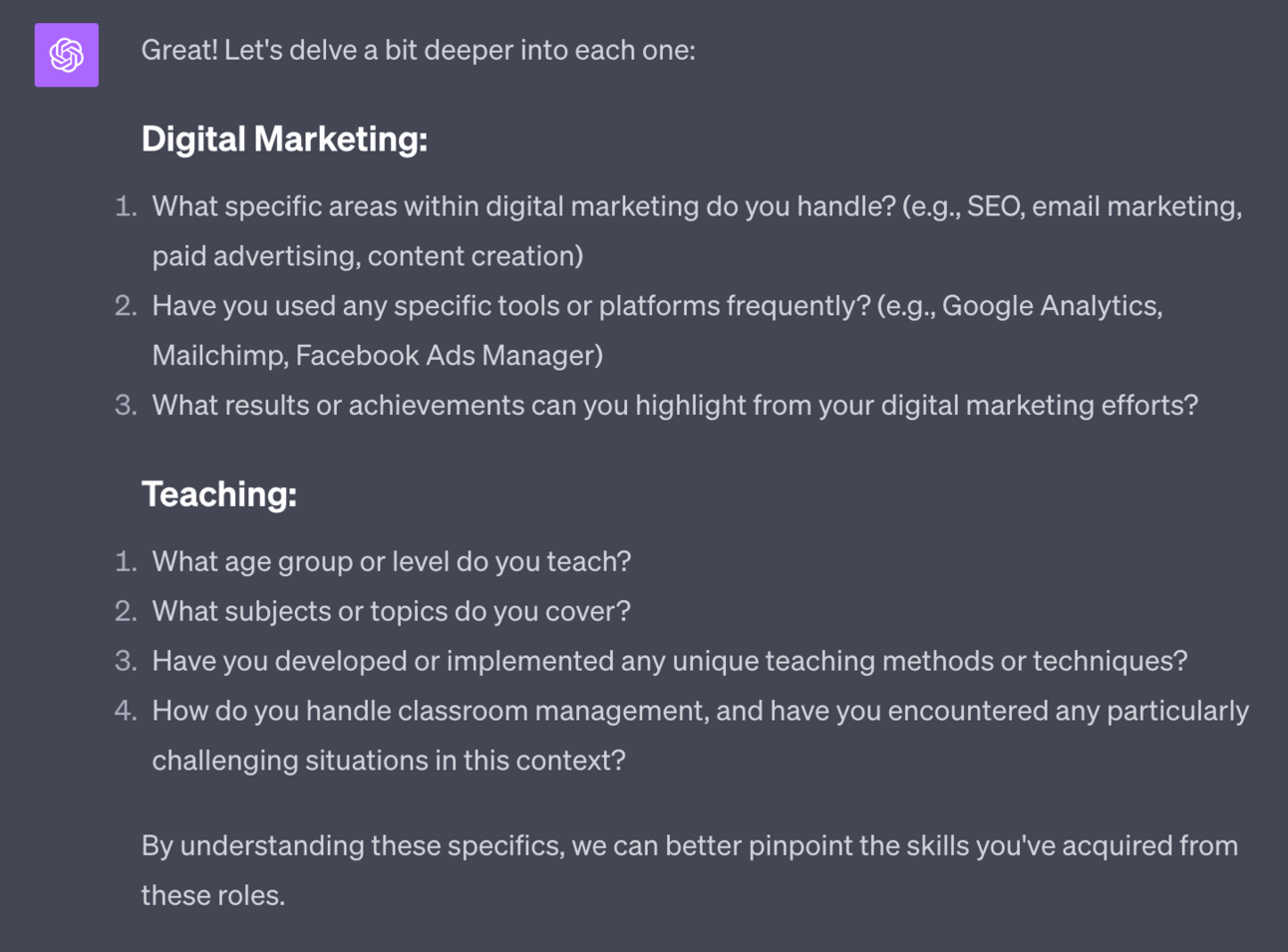
For each area ChatGPT will ask supplemental questions. Answer as much as possible here, using the numbers ChatGPT gave you for simplicity.
Here I respond “Digital Marketing 1 SEO, cold emailing” for the example. I get this response:

Amazing – these are the actual skills involved and I have them all. I just would have struggled to write these out if you point-blank asked me “what are you skills?”
I tell ChatGPT “save these and return to the top level”.
That’ll cause ChatGPT to record these are skills that I have and then it’ll go back to the beginning for me to explore other areas.
Alternatively copy/paste these skills and just restart the process with the same prompt in a new chat.
Continue this process to collect up all your skills from all different facets of your life, work and hobbies.
Warning – this is a long process if you do it properly. But the end result will be a powerful inventory of your skills. We’ll be using this in later steps.
2. Uncovering our strengths
We’re going to run another coaching prompt – this time on our strengths.
What’s the difference?
Strengths are your natural talents or abilities. They are activities you feel intrinsically motivated to do, find energising, and can do well without much formal training. Strengths are often innate and tend to come more naturally.
Skills are learned abilities and competencies, often through study, training or practice over time. Skills may build on natural strengths, but are developed through effort and repetition. You may have skills that aren’t your strengths, and strengths you haven’t yet developed into skills.
There’s a very powerful assessment called the Gallup StrengthsFinder. It’s a 30-40 minute self administered test that finds which of 34 strengths you are particularly strong at.
It’s worth doing if you have the funds – it’s around $60 for one assessment.
However, for the purposes of our current process we can get the basics via ChatGPT:
Perform a strength finder assessment with 30 multiple choice questions
Ask each of the questions, wait for the response and then ask the next question.
Ask multiple question related to each strength to increase the validity of the test. Do not tell me what strength each question relates to so as to not alter my answers.
Get my answer as the answer number
then provide a list of my strengths ranked from top to bottom.💬 Prompt Output:
This prompt will trigger an assessment process, asking one question at a time:

Simply plug in the number from 1 to 5 that resonates with you.
Continue through all the questions until you reach your final result:
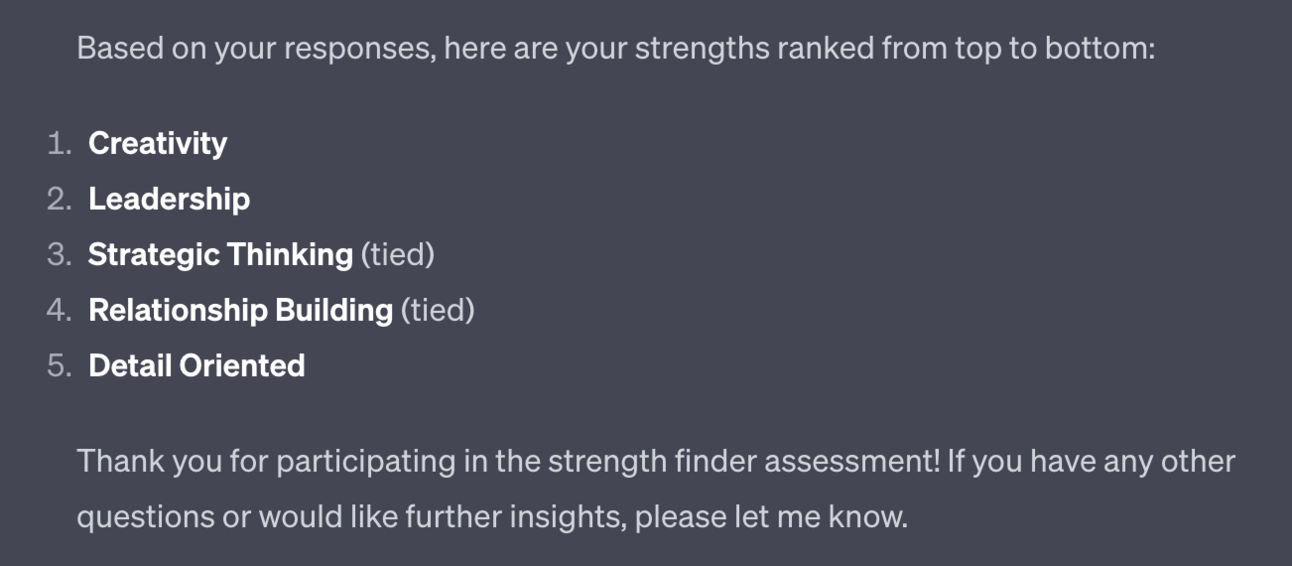
Want this to be even more detailed? Adjust the number of questions asked in the prompt. Doing so allows ChatGPT to assess more strengths. At 30 questions it assesses 5 strengths. At 100 questions it assesses 10 strengths.
Once done keep a note of your strengths along with your list of skills.
3. Finding your flow
One more coaching assessment. We want to find activities that you find enjoyable.
We don’t want to end up with a list like “watching Netflix” and “Playstation”. These are totally reasonable activities for downtime but not generally for a business.
Instead we want to find value creating activities that put you into the state of flow. These aren’t necessarily purely “fun” but instead can be better described as engaging.
Have you ever been so absorbed in an activity that you lost track of time. You started a task and raised your head several hours later to find that it’s dark in the room as the sun’s gone down. You were so focused that you didn’t process information about the outside world.
That’s flow.
If you can find work that puts you in this state you’ll have a great time building your business.
Let’s find what puts you in flow with another coaching prompt.
Act as a coach helping me find fulfilling work.
Specifically, ask me questions to find which tasks put me into a state of flow.
Focus me on valuable creative tasks.
Ask each question one at a time, wait for my response and then move to the next question
Use this to uncover 5 separate tasks that put me into flow
Then extrapolate the commonalities between these tasks to suggest what type of tasks are most likely to put me in flow
Use this to suggest further tasks that may be engaging.💬 Prompt Output:
This prompt will begin questioning you about engaging tasks in the past.
It’ll quickly identify tasks that previously put you in flow. That’s a great start. But it’ll also look for commonalities between the tasks like so:

This list nails me. It’s ignored other common flow states like collaborating with others and instead focused in on my big drivers – creativity, challenge, problem-solving.
Keep note of your list of commonalities. These are the type of activities that will likely put you into flow and thus be perfect for when you come to build a business.

4. Premium Prompt – Coaching Prompts
Free Trial – Premium
We’re providing a free trial of the Premium Prompts. Premium Prompts will be available for members only once our community launches. Stay tuned.
We’ve just used 3 coaching prompts in this Part.
Hopefully you can see the power of coaching prompts and how a well constructed one can help you clarify your thinking and extract valuable information from you.
Lots of people forget you can use ChatGPT for this. As such I want to give a quick how-to on getting ChatGPT to coach you on anything.
Here is a generic coaching prompt template you can adapt:
Act as a [type] coach
Help me work out [your problem statement]
Ask each question one at a time, wait for my response and then move to the next question
Summarise your conclusions and ask if sufficient or whether further changes are needed
Summarise action points.
For example I can plug in “productivity coach” and “help me work out how to stop looking at my phone so much”
ChatGPT walked me through 7 questions to collect the information it needed and then returned this action plan:
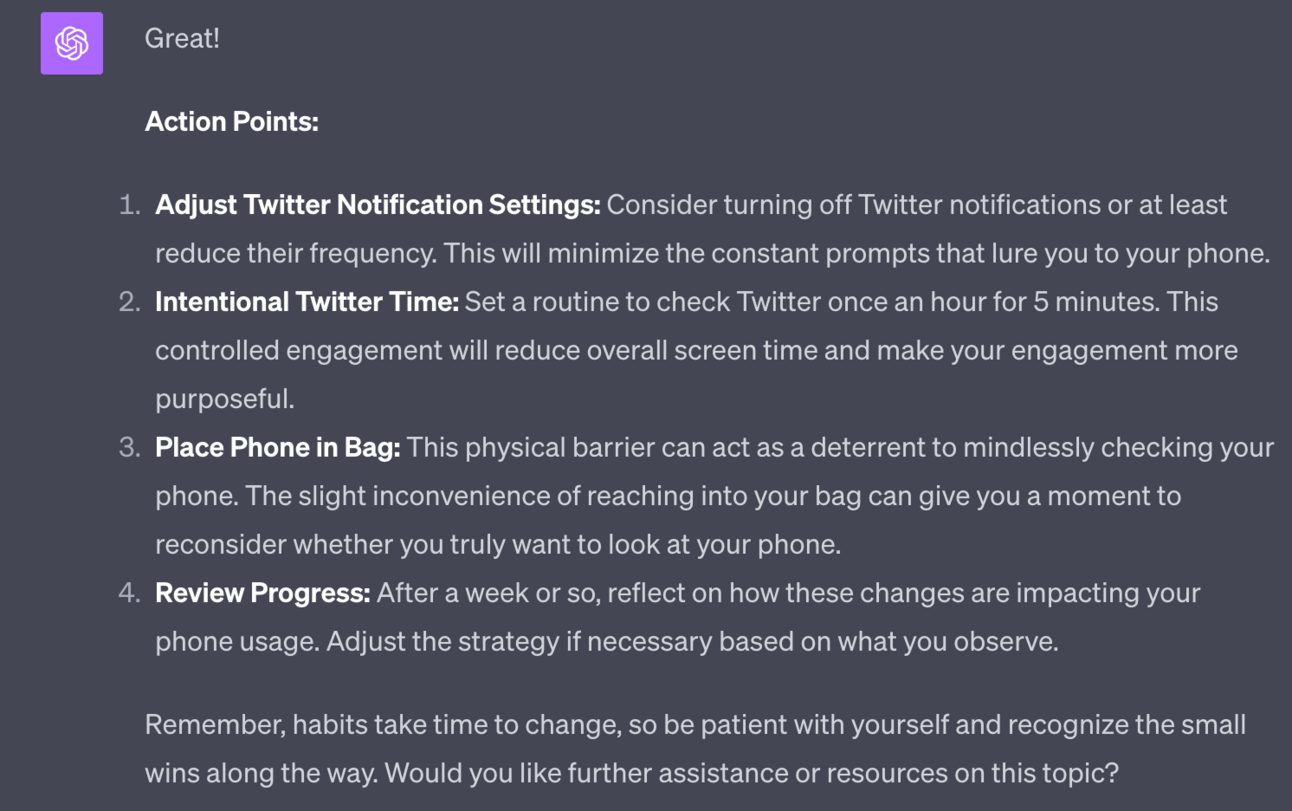
You can adapt this basic coaching prompt to any problems you are having.
Pulling it together
We’ve covered some important foundational work with these coaching prompts. It’s a lot of work to go through these properly.
But at the end of the process you’ll have a strong inventory of skills, strengths and engaging activities that we can start to use to nail your niche.
And hopefully you are now feeling pretty empowered now that you can see all your skills and strengths written down. Look at you, you little superhero!
A reminder of what we’re covering this week :
Part 1: Exploring Your Interests and Skills
Part 2: Getting Clear on Your Motivations
Part 3: Finding Your Niche
Part 4: Validating and Refining Your Idea
Part 5: Planning Next Steps
